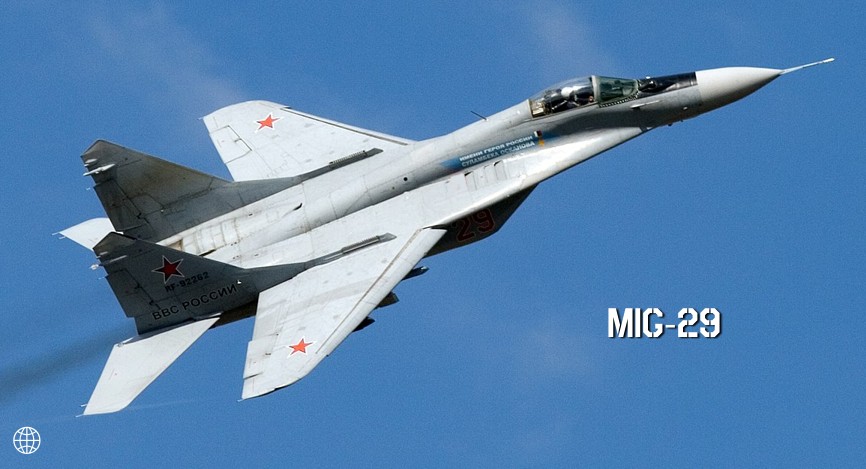MIG-29 FULCRUM, RUSSIA

The MiG-27K fighter bomber aircraft is manufactured by RSK MiG and the Irkutsk Aircraft Production Association Joint Stock Company. The MiG-29, -30 and -33 are known by the NATO code name Fulcrum. The MiG-29K is the carrier-based version. There are in the region of 600 MiG-29 variants in service with the Russian Air Force. The fighter is also in service with the air forces of Algeria (30 aircraft), Bangladesh (eight), Belarus (50), Bulgaria (20), Cuba (18), Eritrea (five), Germany (23), Hungary (21), India (70), Iran (35), Kazakhstan (40), Malaysia (16), Myanmar (ten), North Korea (35), Peru (18), Poland (18), Romania (15), Slovakia (23), Syria (50), Sudan (ten), Turkmenistan (20), Ukraine (220), Uzbekistan (30) and Yemen (24).
The 22 MiG-29 aircraft in the German Air Force have been leased to the Polish Air Force. The first five were handed over in September 2003 and deliveries concluded in August 2004.
16 new MiG-29Ks have been ordered by India to equip the INS Vikramaditya (formerly the Admiral Gorshkov) carrier bought from the Russian Navy, for delivery between 2006 and 2009.
In August 2004, the Defence Ministry of Sudan announced that they planned to acquire a further 12 MiG-29 aircraft, converting options under a contract for ten fighters placed in 2002. Deliveries on the original contract concluded in July 2004.
The mission of the MiG-29 is to destroy hostile air targets within radar coverage limits and also to destroy ground targets using unguided weapons in visual flight conditions. The aircraft's fixed-wing profile with large wing leading edge root extensions gives good manoeuvrability and control at subsonic speed including manoeuvres at high angles of attack. The maximum operational g-loading is 9g.
A two-seater version, MiG-29M2, took its maiden flight in 2001. A super-manouevrable variant, MiG-29OVT, with three-dimensional thrust-vectoring engine nozzles has successfully been demonstrated and is being offered to potential customers as the MiG-35.
UPGRADE PROGRAMMES
The Russian Air Force has begun an upgrade programme for 150 of its MiG-29 fighters, which will be designated MiG-29SMT. The upgrade comprises: increased range and payload, new glass cockpit, digital fly-by-wire control system, new avionics, improved radar, KOLS infrared search and track (IRST) and an in-flight refuelling probe. The radar will be the Phazotron Zhuk-ME which is capable of tracking ten targets to a maximum range of 245km.
12 MiG-29 of the Air Force of Yemen are being upgraded to SMT standard. The first was delivered in October 2004.
EADS (formerly DaimlerChrysler Aerospace) is to upgrade 22 MiG-29 aircraft of the Polish Air Force. Modifications are needed to adapt the aircraft to NATO standards, prior to Poland's entry into NATO. EADS has performed similar modifications to the MiG-29s of the former East German Air Force. EADS has joined with RSK-MiG to offer modernisation packages for the MiG-29 and has signed an agreement with Romania for product support and modernisation. EADS, Aerostar of Romania and Elbit of Israel have also launched an upgrade, MiG-29 Sniper, which includes modernisation and maintenance of the airframe and engines, and upgrades of the avionics with new Elbit digital mission computer and weapon systems, and installation of a glass cockpit.
In February 2004, RSK MiG signed an agreement to upgrade 12 MiG-29 of the Slovak Air Force. The upgrade will include Rockwell Collins navigation and communications systems and BAE Systems IFF (Interrogation Friend or Foe) system. Russian companies will supply the glass cockpit with multi-function LCD displays and digital processors. Deliveries are to commence in 2006.
WEAPONS
The MiG-29 fighter is equipped with seven external weapon hardpoints. The aircraft can carry: up to two R-27 air-to-air medium-range missiles; six R-73 and R-60 air-to-air short range missiles; four pods of S-5, S-8, S-24 unguided rockets; air bombs weighing up to 3,000kg; and 30mm built-in aircraft gun with 150 rounds of ammunition.
The R-27 medium-range air-to-air missile is supplied by the Vympel State Engineering Design Bureau, based in Moscow. The R-27 is available in two configurations: the R-27R, which has a semi-active radar homing head and inertial navigation control with a radio link; and the R-27T missile, which is fitted with an infrared homing head. The missile can intercept targets with a speed of up to 3,500km/hour at altitudes from 0.02-27km, and the maximum vertical separation between the aircraft and the target is 10km.
The Vympel R-73 missile is an all-aspect, short-range air-to-air missile known by the NATO codename AA-11 Archer. The missile has cooled infrared homing and can intercept targets at altitudes between 0.02 and 20km, target g-load to 12g, and with target speeds to 2,500km/hour.
The Vympel R-60 (NATO codename AA-8 Aphid) short-range air-to-air missile can engage targets manoeuvring at an acceleration up to 12g. The R-60M has an expanded range of target designation angles to +/- 20 degrees, a heavier warhead and an upgraded infrared homing head with photodetector cooling.
TARGETING
The aircraft is equipped with an information and fire control radar system comprising: an N-019 radar developed by Phazotron Research and Production Company, Moscow; an infrared search and track sensor; a laser rangefinder; and a helmet-mounted target designator.
For longer-range air combat, the MiG-29 uses radar guidance for the R-27 missile.
ENGINES
The MiG-29 is equipped with two RD-33 turbofan engines. The MiG-29 is the world's first aircraft fitted with dual-mode air intakes. During flight, the open air intakes feed air to the engines. While moving on the ground, the air intakes are closed and air is fed through the louvres on the upper surface of the wing root to prevent ingestion of foreign objects from the runway. This is particularly important when operating from poorly prepared airfields.
The engines provide a maximum speed of 2,400km/hour at altitude and 1,500km/hour near the ground and the service ceiling is 18,000m. The maximum range at altitude is 1,500km and 700km near the ground.